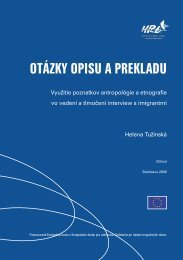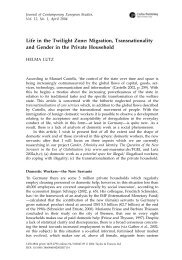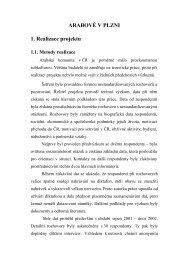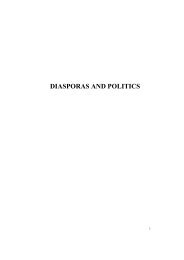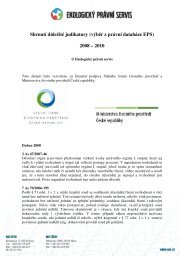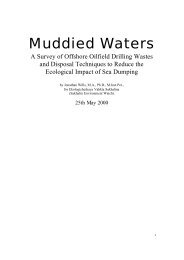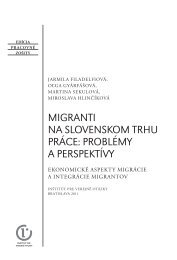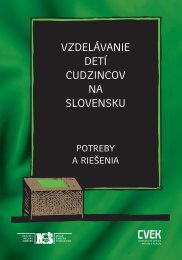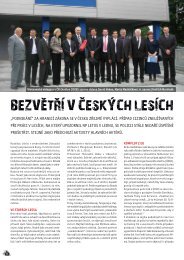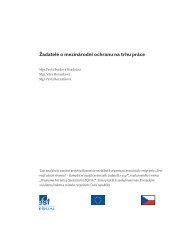Migration Processes in Central and Eastern Europe - Multiple Choices
Migration Processes in Central and Eastern Europe - Multiple Choices
Migration Processes in Central and Eastern Europe - Multiple Choices
You also want an ePaper? Increase the reach of your titles
YUMPU automatically turns print PDFs into web optimized ePapers that Google loves.
———————————————————————————————————————————————————————————————<br />
Construction of Borders <strong>and</strong> Practices of Labour <strong>Migration</strong><br />
———————————————————————————————————————————————————————————————<br />
A variable degree <strong>in</strong> household dependency,<br />
stimulated by the shortage of money on the Romanian side<br />
<strong>and</strong> the shortage of labour, accompanied by the development<br />
of “post-<strong>in</strong>dustrial lifestyles” among the former Serbian<br />
guest workers who came back from Germany, should be<br />
noted. F<strong>in</strong>ally, the stories of my <strong>in</strong>formants are very useful<br />
<strong>in</strong> illustrat<strong>in</strong>g the relations of dependence between different<br />
exp<strong>and</strong><strong>in</strong>g <strong>in</strong>formal labour markets: the Austrian <strong>and</strong><br />
Serbian on one h<strong>and</strong>, Serbian <strong>and</strong> Romanian, on the other.<br />
To put it simply, I will use the words of a day labourer:<br />
“We live on the Serbs, <strong>and</strong> the Serbs do the same from the<br />
Austrians”.<br />
1 This paper is an abridged <strong>and</strong> revised version of Radu, Cosm<strong>in</strong>:<br />
“We are all tourists”. Informal Labour Markets <strong>and</strong> Socioeconomic<br />
Practices on Romania-Serbia border <strong>in</strong> different mobility regimes,<br />
<strong>in</strong>: Bacas, J.L. <strong>and</strong> W. Kavanagh (Eds.), Asymmetry <strong>and</strong> Proximity<br />
<strong>in</strong> Border Encounters. Oxford: Berghahn Books (forthcom<strong>in</strong>g<br />
<strong>in</strong> 2006).<br />
2 Wallace <strong>and</strong> Stola (2000) offer an analysis of <strong>Central</strong> <strong>Europe</strong><br />
as a buffer zone <strong>and</strong> of East-<strong>Central</strong>-West migration processes.<br />
They <strong>in</strong>troduce concepts such as “temporary”, “<strong>in</strong>complete”<br />
or “transnational migration”.<br />
3 By embeddedness I underst<strong>and</strong> “the extent to which an actor<br />
is 'anchored' <strong>in</strong> a particular territory or place. Economic actors<br />
become embedded there <strong>in</strong> the sense that they absorb, <strong>and</strong> <strong>in</strong> some<br />
cases become constra<strong>in</strong>ed by, the economic activities <strong>and</strong> social<br />
dynamics that already exist <strong>in</strong> those places” (Hess 2004: 177).<br />
Accord<strong>in</strong>g to Mart<strong>in</strong> Hess the applications of the concept<br />
of “embeddedness” need to be scaled geographically, follow<strong>in</strong>g<br />
the economic geographical research tradition.<br />
BIBLIOGRAPHY<br />
•• Berg, E. (2000). Border cross<strong>in</strong>g <strong>in</strong> manifest perceptions<br />
<strong>and</strong> actual needs. In M. van der Velde <strong>and</strong> H. van Houtum<br />
(Eds.), <strong>Europe</strong>an Research <strong>in</strong> Regional Science: Borders,<br />
regions <strong>and</strong> people (Volume 10). London: Pion Ltd.<br />
•• Hess, M. (2004). Spatial relationships? Towards<br />
a reconceptualization of embeddedness. Progress<br />
<strong>in</strong> Human Geography 28 (2), 165-186.<br />
•• Konstant<strong>in</strong>ov, Y., Kressel, G.M. <strong>and</strong> T. Thuen (1998).<br />
Outclassed by former outcasts: Petty trad<strong>in</strong>g <strong>in</strong> Varna.<br />
American Ethnologist 25 (4), 729-745.<br />
•• Neef, R. (2002). Observations on the concept <strong>and</strong> forms<br />
of the <strong>in</strong>formal economy <strong>in</strong> <strong>Eastern</strong> <strong>Europe</strong>, 1-27. In<br />
R. Neef, <strong>and</strong> M. Stänculescu (Eds.), The social impact of<br />
<strong>in</strong>formal economies <strong>in</strong> <strong>Eastern</strong> <strong>Europe</strong>, Aldershot: Ashgate.<br />
•• Wallace, C. <strong>and</strong> D. Stola (Eds.) (2001). Patterns<br />
of migration <strong>in</strong> <strong>Central</strong> <strong>Europe</strong>. Houndmills, Bas<strong>in</strong>gstoke:<br />
Palgrave Macmillan.<br />
•• Wallace, C. (2002). Open<strong>in</strong>g <strong>and</strong> clos<strong>in</strong>g borders:<br />
<strong>Migration</strong> <strong>and</strong> mobility <strong>in</strong> East-<strong>Central</strong> <strong>Europe</strong>.<br />
Journal of Ethnic <strong>and</strong> <strong>Migration</strong> Studies 28 (4), 603-625.<br />
19<br />
Cosm<strong>in</strong> Radu<br />
The author is a PhD student of University<br />
of Bucharest, Faculty of Sociology. His work<br />
as a PhD student is focused on Romania <strong>and</strong> the<br />
small-scale cross-border labour <strong>and</strong> trade with<br />
Serbia, Ukra<strong>in</strong>e, <strong>and</strong> the Republic of Moldova.<br />
He can be contacted at: yotile@yahoo.com.<br />
<strong>Migration</strong> <strong>Processes</strong> <strong>in</strong> <strong>Central</strong> <strong>and</strong> <strong>Eastern</strong> <strong>Europe</strong>: Unpack<strong>in</strong>g the Diversity



